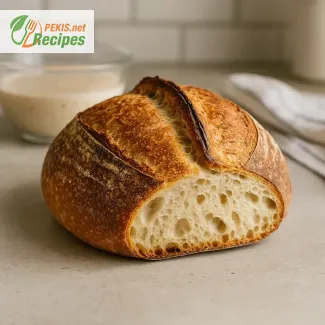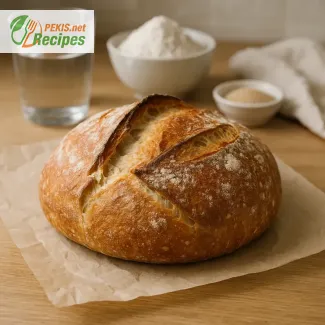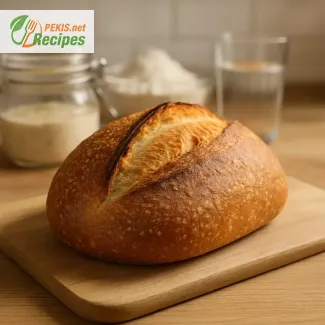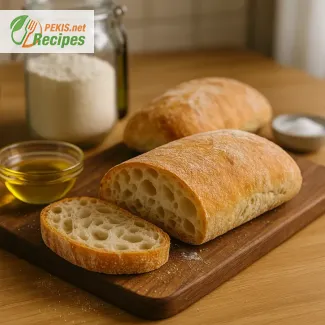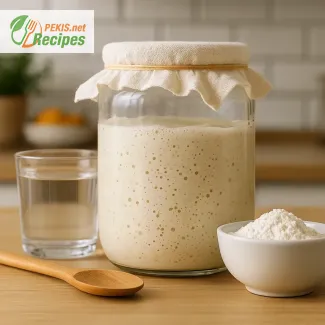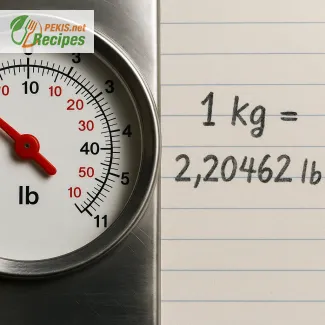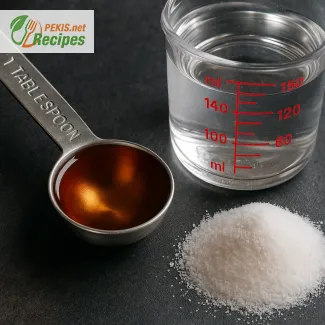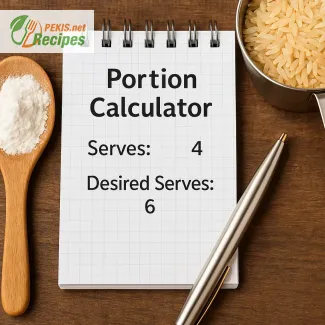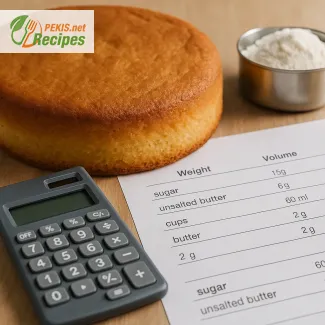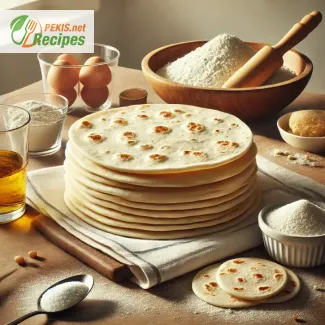
Mastering Soft Homemade Tortillas from Scratch
Discover the timeless craft of making fresh, pillowy tortillas at home
There’s something incredibly satisfying about preparing your own soft, homemade tortillas—the kind that are still warm from the pan, flexible yet tender, and infused with a subtle, comforting aroma of flour and toasted dough. Whether you're assembling street-style tacos, rolling burritos, or serving fresh quesadillas, a homemade tortilla recipe offers a level of quality and flavor that store-bought simply can't match.
This guide takes you deep into the process of making authentic homemade tortillas that are consistently soft, fresh, and easy to prepare—even for beginners. Unlike dense or chewy pre-packaged versions, these tortillas are delicate and pliable, with just the right texture to hold any filling without cracking or drying out.
Why homemade tortillas make every dish better
Freshly made tortillas are more than just a vessel for your favorite Mexican or Tex-Mex fillings—they elevate the entire experience. The difference is immediately noticeable: softness, aroma, and flavor come together to transform even the simplest ingredients into something extraordinary.
Using just a handful of pantry staples—all-purpose flour, salt, baking powder, and oil—you can create a dough that’s versatile, forgiving, and highly adaptable. The secret lies in the balance of ingredients and the proper handling of the dough: too dry, and the tortilla cracks; too wet, and it sticks. But get it right, and you’ll be rewarded with warm, flexible tortillas that are perfect for any meal of the day.
The texture that defines a perfect tortilla
What sets this best tortilla recipe apart is its focus on achieving the ideal balance between softness and structure. These tortillas bend easily around your fillings without tearing and are tender enough to chew with satisfaction. The texture isn’t gummy or tough—it’s light and moist, with a faint char from the pan that adds a subtle smokiness.
Proper resting of the dough is crucial. This allows the gluten to relax, making the dough easier to roll thinly without springing back. When pressed into discs and cooked on a hot griddle or skillet, the tortillas puff gently, developing air pockets that make them light and pillowy.
A recipe built for consistency and success
Whether you're making 8 tortillas or 40, this easy tortilla recipe scales effortlessly and delivers consistent results. No special equipment is required—just a bowl, rolling pin, and a flat skillet or griddle. You don’t need a tortilla press, although it can make things faster if you're preparing a large batch.
Each tortilla takes just a minute or so to cook. The dough is forgiving, and even if your shapes aren’t perfect at first, they’ll still taste incredible. Over time, you’ll develop a feel for the dough’s texture and elasticity, and your tortillas will only improve.
Common mistakes and how to avoid them
Several pitfalls can compromise your homemade tortillas, but they’re easy to avoid once you know what to watch for. A few of the most frequent issues include:
- Overworking the dough: Knead just enough to bring the dough together smoothly, but don’t overdo it—this can make tortillas tough.
- Skipping the resting time: Resting the dough is essential for easy rolling and tender results.
- Underheating the pan: A hot skillet ensures a quick puff and golden brown spots. A cold pan leads to dry, uneven tortillas.
- Overcooking: Just 30–60 seconds per side is enough. Overcooking can make them dry and brittle.
Paying attention to these details will help you achieve professional-level results even in a home kitchen.
Customizing your tortillas for every occasion
While traditional flour tortillas are a staple, this base recipe invites customization. You can:
- Substitute whole wheat flour for a nuttier flavor and more fiber
- Add herbs or spices like cumin, paprika, or garlic powder to the dough
- Use olive oil, lard, or butter depending on your flavor preference
- Create mini tortillas for street tacos or extra-large ones for wraps and burritos
Tortillas also freeze well, making it easy to prepare a large batch and store them for later. Simply cool completely, stack with parchment paper in between, and freeze in an airtight bag. A quick reheat in a hot pan brings them back to life.
Why this recipe works for both beginners and pros
This recipe is designed to be foolproof, no matter your skill level. If you’re new to cooking, the clear step-by-step instructions make it approachable. If you’re a seasoned home cook, the consistency and adaptability of this dough will meet your expectations.
What makes it reliable is the attention to ratios and technique. The dough holds moisture without being sticky. The resting stage makes rolling smooth and stress-free. And the quick cook time means you can have fresh, warm tortillas on the table in under 30 minutes.
Fresh, soft tortillas at your fingertips
In an era of fast food and shortcuts, making your own tortillas may seem like an unnecessary step—but once you taste the results, there’s no turning back. The flavor, texture, and freshness of homemade tortillas simply can’t be duplicated by anything pre-packaged.
You’re not just following a recipe—you’re reclaiming a kitchen tradition that’s deeply satisfying and incredibly practical. From family dinners to casual lunches, taco nights to snack wraps, these tortillas form the base of countless dishes. And with just a bit of practice, making them becomes second nature.
Perfect for any meal of the day
These soft tortillas are the perfect companion to a wide range of meals:
- Breakfast burritos with scrambled eggs, avocado, and hot sauce
- Lunch wraps filled with grilled chicken, crunchy greens, and creamy dressing
- Dinner tacos bursting with seasoned beef, beans, and roasted vegetables
- Quick snacks layered with cheese and toasted into quesadillas
The beauty of this recipe is in its flexibility: use them fresh off the pan, warm them for a few seconds before serving, or fill and fold them cold. They’re always tender, always tasty, and always ready to serve.
1. Combine dry ingredients
In a large mixing bowl, whisk together all-purpose flour, baking powder, and salt until evenly distributed.
2. Add liquids
Pour in the warm water and vegetable oil. Mix with a spoon or your hands until a shaggy dough forms.
3. Knead the dough
Transfer the dough to a lightly floured surface and knead for about 5 minutes, until the dough is smooth and elastic. It should not be sticky.
4. Rest the dough
Place the dough back in the bowl, cover with a clean towel or plastic wrap, and let it rest at room temperature for 20 minutes. This step relaxes the gluten for easier rolling.
5. Divide and shape
Divide the rested dough into 8 equal portions. Roll each into a ball using your palms. Let them rest for another 10 minutes under a towel to prevent drying.
6. Roll out tortillas
Using a rolling pin, roll each ball into a round disc about 18–20 cm (7–8 inches) in diameter. If needed, lightly dust with flour to prevent sticking.
7. Cook tortillas
Preheat a dry skillet or griddle over medium-high heat. Cook each tortilla for 30–45 seconds per side, or until it begins to puff and gets golden-brown spots. Adjust heat as needed to prevent burning.
8. Keep warm
Transfer cooked tortillas to a plate and cover with a clean towel to keep them soft and warm. Serve immediately or cool and store.
Transforming a Classic: Ways to Enhance Your Homemade Tortillas
Ingredient upgrades and expert tips for elevated results every time
Perfecting a batch of homemade tortillas can feel like mastering a culinary ritual—simple, yet deeply nuanced. While the basic ingredients of flour, water, oil, salt, and baking powder can deliver excellent results, understanding how to refine and customize this traditional recipe brings the experience to a new level. With a few smart adjustments, you can create tortillas that are even softer, more flavorful, and better aligned with your dietary goals.
The secret power of flour selection
The foundation of any tortilla is the flour, and choosing the right type can dramatically affect both texture and taste. Standard all-purpose flour provides a soft yet elastic base, but consider experimenting with alternatives:
- Bread flour contains more gluten, resulting in chewier, more structured tortillas.
- Whole wheat flour adds a nutty, earthy depth of flavor while increasing fiber content. For balance, mix 50/50 with all-purpose flour to maintain softness.
- For a gluten-free option, use a certified blend designed for baking. Add a binding agent like xanthan gum for elasticity.
Choosing higher-quality flour also makes a notable difference in the final product, affecting color, pliability, and overall taste.
Elevating flavor with fat
Most traditional tortilla recipes use neutral vegetable oil, but switching up the fat can significantly enrich the flavor:
- Olive oil imparts a gentle fruity note and adds antioxidants.
- Butter, melted before incorporating, introduces a richer, more savory aroma.
- Lard delivers authentic Mexican texture and flavor, resulting in ultra-soft tortillas with just the right amount of chew.
Using cold fats like butter or lard in small flakes—rather than melted—can also mimic a shortcrust effect, giving the tortilla a flakier, layered structure when cooked.
Infusing character with herbs and spices
To add a signature touch, consider blending dried herbs or spices directly into the dough:
- Garlic powder, smoked paprika, or cumin gives tortillas a savory twist, especially suited for grilled meats.
- Chili flakes or black pepper introduce a mild heat.
- For a vibrant look, finely chopped fresh herbs like cilantro or parsley can be kneaded in just before rolling.
These additions subtly perfume the dough and lend your tortillas an unmistakable homemade charm that makes them stand out.
The role of hydration and dough texture
The feel of the dough is as critical as the ingredients. A well-hydrated dough (not too dry, not too sticky) ensures even puffing and rolling without tearing. If your dough feels tough or cracks while rolling, add a teaspoon of warm water at a time, kneading gently until pliable. Conversely, if it’s too wet, dust lightly with flour and knead again until smooth.
Letting the dough rest after kneading is non-negotiable—this relaxes the gluten, allowing you to roll the tortillas thinner without resistance. For best results, divide and shape your dough portions before resting them again, covered with a damp cloth to prevent drying out.
Common mistakes that ruin texture and flavor
Even a simple recipe like this comes with potential pitfalls. The most frequent mistakes include:
- Overcooking: More than 45 seconds per side can make tortillas dry and brittle.
- Underheating the skillet: Leads to pale, dense tortillas with no browning or puff.
- Skipping the second rest: Causes dough to shrink back when rolling.
- Storing improperly: Leaving cooked tortillas uncovered dries them out. Always stack with a towel or store in a sealed container.
Being aware of these details helps you achieve restaurant-quality results at home, every time.
Healthier substitutions without losing texture
For those looking to make health-conscious versions, there are several ways to reduce calories or enhance nutritional value without sacrificing softness or flavor:
- Replace part of the all-purpose flour with chickpea flour or oat flour for added protein and fiber.
- Use avocado oil instead of vegetable oil for a dose of heart-healthy fats.
- Reduce the sodium by half and compensate with a pinch of herbs for flavor.
- Swap in yogurt or unsweetened almond milk for water to increase moisture and nutrient content.
These adjustments allow for nutrient-dense tortillas that fit into a wide range of dietary goals.
Why homemade always wins
Store-bought tortillas are undeniably convenient, but they often contain preservatives, stabilizers, and added sugars to extend shelf life. Fresh homemade tortillas, on the other hand, are free from unnecessary additives and have a superior taste and texture. They’re also highly customizable—you can control thickness, flavor, softness, and size based on the meal you're preparing.
From the first bite, the difference is clear. The combination of warmth, flexibility, and a hint of toasty flour makes homemade tortillas more than just a wrap—they become an integral part of the meal's flavor and experience.
Smart preparation and storage for long-lasting softness
Once cooked, keep tortillas stacked in a clean, dry kitchen towel or wrap them in foil to retain heat and moisture. If preparing in advance, store cooled tortillas in an airtight container or zip-top bag with parchment paper between each one. Refrigerated tortillas last up to 4 days; frozen tortillas keep for 1 month or longer.
Reheat on a dry skillet or over a flame for a few seconds per side. Avoid microwaving, as it can make them chewy or rubbery.
Bonus: turning tortillas into something more
Homemade tortillas aren't limited to wraps—they’re versatile and can become:
- Tortilla chips: cut into triangles, brushed with oil, and baked
- Tostadas: crisped on a pan and topped with beans, salsa, and cheese
- Mini pizza bases: lightly toasted and topped with tomato sauce and mozzarella
- Breakfast cups: pressed into muffin tins and baked with eggs and vegetables
These ideas showcase how a simple, well-made tortilla can serve as a canvas for limitless creativity in the kitchen.
Allergens present in the recipe:
- Gluten (from all-purpose flour)
Suggestions for allergen-free and gluten-free substitutions:
- Replace all-purpose flour with certified gluten-free flour blend containing xanthan gum.
- If allergic to wheat but not gluten, use spelt flour (check tolerability).
- For low-gluten diets, try a mix of rice flour and tapioca starch, but note texture may differ.
Vitamins and minerals per serving (approximate):
- Iron: 1.4 mg – contributes to oxygen transport and energy production
- Calcium: 9 mg – supports bone health
- Magnesium: 8 mg – essential for nerve function and muscle regulation
- Potassium: 42 mg – helps regulate fluid balance and blood pressure
- Vitamin B1 (Thiamine): 0.1 mg – supports energy metabolism and nervous system
Antioxidants per serving (approximate):
- Vitamin E: 0.3 mg – protects cells from oxidative stress
- Polyphenols (from vegetable oil): 5–10 mg – may reduce inflammation and support heart health
- Flavonoids: minimal, but present in trace amounts depending on oil type used (e.g. olive oil provides more)
